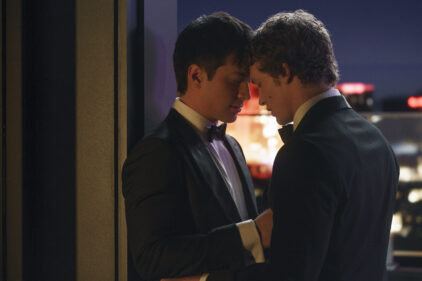Chiwetel Ejiofor stars in “The Man Who Fell to Earth” as Faraday, an alien who shows up in New Mexico on a mission that will help save his home planet. He needs the help of a former MIT scientist named Justin Falls (Naomie Harris), who now takes care of her ailing father Josiah, illegally procuring painkillers for him, and her daughter Molly (Annelle Olaleye). Justin previously pursued a new energy source idea that could help save the world, but was shot down when she didn’t get it entirely right. But here comes Faraday, initially naked and barely without a sense of how to talk to humans, guzzling water. He has arrived on Earth knowing that she can help him, and that she will eventually understand that the desert-like conditions that have destroyed his planet will—not could—also happen here.
Faraday makes a few stops in the journey, like reaching a certain transmission spot in New Mexico that turns out to be the center of a tornado, and later to a tech empire called Origin in Seattle. An introducing scene in episode one shows us Faraday from a podium, as a massive tech guru with a sold-out crowd, ready to unleash a world-changing energy source. We know that he achieves success more or less, and that this is his life-story. The framing device slightly takes away from the story’s overall “save two worlds” tension, even though we know mastering technology is par for the course for the gist of a “Man Who Fell to Earth” story.
Meanwhile, Jimmi Simpson’s CIA agent Spencer Clay catches wind of these strange activities happening in New Mexico, especially after a tornado comes with a strange signal that hasn’t been seen in four decades. Hyper-focused and with an uncertain moral compass, he becomes fixated on understanding the transmission, and he starts to uncover more about the legacy of former tech guru Thomas Newton and his company World Enterprises.

Co-created and often co-written by Alex Kurtzman (“The Mummy”) and Jenny Lumet (“Rachel Getting Married“), the series has a blockbuster movie’s sheen, but stays fairly grounded. The series is notably savvy about how to address the text that people most associate with this story—not so much Walter Tevis’ novel, but the 1976 film directed by Nicolas Roeg, starring David Bowie. Smartly presenting itself as a type of sequel, it uses certain passages from that movie, like a traumatic surgery scene, and an iconic image of Bowie’s Thomas Newton covering his face with a hat, to add color. (It also casts Bill Nighy as Newton here, so that the role can live on with no qualms.) In a thematic sense, this all makes Kurtzman and Lumet’s “The Man Who Fell to Earth” more about people rectifying a past that has reemerged, facing questions that are not answered. It’s a good way to let this series have its own heart and soul.
The writing sometimes takes too long to truly get things going, weighed down by creating its episode-by-episode mysteries instead of being fired up by them. But that’s where the collective charisma of its cast kicks in, as they are able to fill in a great deal of the show’s gaps. Ejiofor is often fascinating as an outsider learning how to be human, interaction by interaction, while being off-putting and strange to everyone around him. He doesn’t know certain mores, like how you don’t just scream “F**K!” in a public place, and when he says something like “I have four stomachs” with a wide-open gaze, it does not have the kind of whimsy or magic that would kill its sincerity. His performance is also where the show (in its first four episodes at least) makes the most effort to talk about what makes a modern human. Taking a wildly different approach than Bowie’s minimalist own title performance, Ejiofor charts his own path of discovery in “The Man Who Fell to Earth,” which includes an always expressive face, a messianic calm, and an unpredictable reaction.
The cast is about massive energies, and Ejiofor finds a great opposite to Naomie Harris’ Justin. With all of the stress and responsibility on her shoulders, she can be intense in her own right, and she has a degree of fear as she learns more and more about Faraday, and starts to believe that he might be more than just an eccentric drifter. Harris is illustrative in a role that makes the show’s unexpected journey more involving. And speaking of energy, pull a motormouth Rob Delaney from left field and add a scene-stealing Clarke Peters to the mix, and you get numerous scenes that are punchy and full of color, as the script nonetheless tiptoes to its latest plot point.
It’s particularly uncertain after four episodes how this will stretch to ten without significant fatigue, especially as “The Man Who Fell from Earth” establishes that it’s less solemn, and more polished than the primal interludes from Roeg’s film, which tried to pack the whole of human existence into its 140 minutes of Panavision cinematography. This version is a bit too eager to please to make such tangents. As of now, it only finds cursory moments to get into what it means to be human; but with more episodes to go, there’s ample room for it to find more time about how Faraday functions as an immigrant. Faraday contains a great deal of mystery, and that includes his motivation of hope and discovery. The show, at least in is takeoff, has enough of both of those to make you want to see what happens next.
Four episodes screened for review. “The Man Who Fell to Earth” premieres on Showtime on April 24th.












